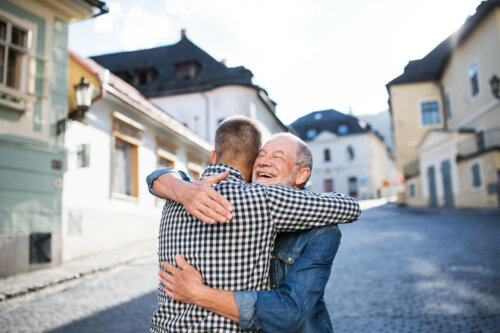Four Types of Hugs and Their Benefits According to Science

When it comes to human communication, non-verbal language is essential. Believe it or not, it provides more than half of the information we receive. In this context, hugs are significant elements in daily interaction. Think about it for a second: imagine just how emotionally close you feel to someone after you hug them for a few minutes. Undoubtedly, hugs allow you to express a lot with only a simple gesture.
When you hear the word “hug”, an intimate and affective exchange usually comes to mind. But, in all honesty, a hug can take place in very different contexts and have very different meanings. For that reason, there are different types of hugs you should be aware of. If you want to explore this topic further, continue reading.
What types of hugs are there?
Friendly hugs
Friendly hugs can include all those that denote camaraderie, companionship, or sympathy. Physical contact isn’t excessively close and the level of intimacy isn’t high either. This way, the emotions that arise through this type of hug are predominantly mutual appreciation, support, or liking.
Usually, these hugs have some kind of “aggressive” component. For example, grabbing the other person by the neck or patting them on the back. This happens especially between men. This is also the case of the so-called “side hugs”, which you give by passing your arm over the other person’s shoulders while looking in the same direction as them.

Affectionate hugs
Hugs are an essential element when looking to express brotherly affection or romantic love. In this context, physical contact is much closer, intimate, and intense. Usually, your body joins the other person’s while both of your heads are placed next to each other. Your arms intensely embrace the other person and, more often than not, this exchange lasts longer than in the previous case.
Furthermore, meaningful relationships that have an emotional component in them are the ones who tend to take advantage of this type of hug. It conveys love, complicity, and genuine affection. Back hugs also fall into this category. These, in addition to all of the above, also denote a desire to protect and care for the other.
Sensual hugs
Given the physical and bodily closeness that occurs in a hug, this action also takes part in interactions with sexual connotations, which take place between people who are attracted to each other. Now, most people link eroticism and sexual desire to kisses. However, hugs also play an essential role in this regard.
A good example of this would be those hugs that occur while one person is sitting on a raised surface and the other is standing. Another would be those that occur when one member of the couple supports the weight of the other with th1eir arms, while they surround their partner’s waist with their legs. These hugs are very intimate since they reflect passion, desire, and even lust.

Awkward hugs
It’s important to mention that not all types of hugs are positive. There are times and circumstances when this interaction occurs out of commitment, reluctance, or displeasure. For example, having to greet someone you don’t trust or having to hug someone who you don’t personally like. Most people have been in this type of situation once or twice.
The main characteristic of this hug is that, despite the fact that the bodies are joined at the top, from the waist down there’s a considerable distance. In some cases, one of the parties may hug the other with love and excitement, while the other person doesn’t even embrace them with their arms.
Types of hugs and their benefits
Hugs have clear benefits in interpersonal relationships. When meeting someone, they help to “break the ice” and initiate friendly contact. Hugging someone you care about allows you to strengthen your bond with that person, plus there’s an increase in emotional closeness. In the same way, couple relationships are highly enriched by frequent hugs between their members.
Nonetheless, on a personal level, giving and receiving hugs also has a positive impact on health. For example, hugging has been shown to lower blood pressure and heart rate (it has a calming effect). They lower body cortisol levels and enhance the secretion of oxytocin, thus reducing fear and stress while increasing pleasant sensations, self-esteem, generosity, and a sensation of overall well-being.
Hugs are able to relieve pain, improve the immune system, and even enhance cognitive abilities. In brief, it’s a simple but extremely powerful resource that’s available to everyone. Let’s make good use of it.
When it comes to human communication, non-verbal language is essential. Believe it or not, it provides more than half of the information we receive. In this context, hugs are significant elements in daily interaction. Think about it for a second: imagine just how emotionally close you feel to someone after you hug them for a few minutes. Undoubtedly, hugs allow you to express a lot with only a simple gesture.
When you hear the word “hug”, an intimate and affective exchange usually comes to mind. But, in all honesty, a hug can take place in very different contexts and have very different meanings. For that reason, there are different types of hugs you should be aware of. If you want to explore this topic further, continue reading.
What types of hugs are there?
Friendly hugs
Friendly hugs can include all those that denote camaraderie, companionship, or sympathy. Physical contact isn’t excessively close and the level of intimacy isn’t high either. This way, the emotions that arise through this type of hug are predominantly mutual appreciation, support, or liking.
Usually, these hugs have some kind of “aggressive” component. For example, grabbing the other person by the neck or patting them on the back. This happens especially between men. This is also the case of the so-called “side hugs”, which you give by passing your arm over the other person’s shoulders while looking in the same direction as them.

Affectionate hugs
Hugs are an essential element when looking to express brotherly affection or romantic love. In this context, physical contact is much closer, intimate, and intense. Usually, your body joins the other person’s while both of your heads are placed next to each other. Your arms intensely embrace the other person and, more often than not, this exchange lasts longer than in the previous case.
Furthermore, meaningful relationships that have an emotional component in them are the ones who tend to take advantage of this type of hug. It conveys love, complicity, and genuine affection. Back hugs also fall into this category. These, in addition to all of the above, also denote a desire to protect and care for the other.
Sensual hugs
Given the physical and bodily closeness that occurs in a hug, this action also takes part in interactions with sexual connotations, which take place between people who are attracted to each other. Now, most people link eroticism and sexual desire to kisses. However, hugs also play an essential role in this regard.
A good example of this would be those hugs that occur while one person is sitting on a raised surface and the other is standing. Another would be those that occur when one member of the couple supports the weight of the other with th1eir arms, while they surround their partner’s waist with their legs. These hugs are very intimate since they reflect passion, desire, and even lust.

Awkward hugs
It’s important to mention that not all types of hugs are positive. There are times and circumstances when this interaction occurs out of commitment, reluctance, or displeasure. For example, having to greet someone you don’t trust or having to hug someone who you don’t personally like. Most people have been in this type of situation once or twice.
The main characteristic of this hug is that, despite the fact that the bodies are joined at the top, from the waist down there’s a considerable distance. In some cases, one of the parties may hug the other with love and excitement, while the other person doesn’t even embrace them with their arms.
Types of hugs and their benefits
Hugs have clear benefits in interpersonal relationships. When meeting someone, they help to “break the ice” and initiate friendly contact. Hugging someone you care about allows you to strengthen your bond with that person, plus there’s an increase in emotional closeness. In the same way, couple relationships are highly enriched by frequent hugs between their members.
Nonetheless, on a personal level, giving and receiving hugs also has a positive impact on health. For example, hugging has been shown to lower blood pressure and heart rate (it has a calming effect). They lower body cortisol levels and enhance the secretion of oxytocin, thus reducing fear and stress while increasing pleasant sensations, self-esteem, generosity, and a sensation of overall well-being.
Hugs are able to relieve pain, improve the immune system, and even enhance cognitive abilities. In brief, it’s a simple but extremely powerful resource that’s available to everyone. Let’s make good use of it.
All cited sources were thoroughly reviewed by our team to ensure their quality, reliability, currency, and validity. The bibliography of this article was considered reliable and of academic or scientific accuracy.
- Washington, M. D. (2008, 11 febrero). The healing power of hugs. Recuperado 4 de diciembre de 2020, de https://www.academia.edu/8062471/The_Healing_Power_of_Hugs
- Light, K. C., Grewen, K. M., & Amico, J. A. (2005). More frequent partner hugs and higher oxytocin levels are linked to lower blood pressure and heart rate in premenopausal women. Biological psychology, 69(1), 5-21.
This text is provided for informational purposes only and does not replace consultation with a professional. If in doubt, consult your specialist.







